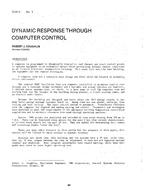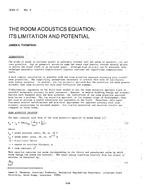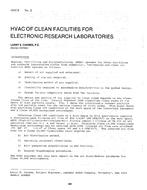-
-
Available Formats
- Options
- Availability
- Priced From ( in USD )
-
Available Formats
-
- Immediate download
- $16.00
- Add to Cart
Customers Who Bought This Also Bought
-

CI-81-01-3 -- Dynamic Response through Computer Control
Priced From $16.00 -

CI-81-12-2 -- The Room Acoustics Equation: Its Limitation...
Priced From $16.00 -

CI-81-07-2 -- Test Data versus F-Chart Predictions for Tw...
Priced From $16.00 -

CI-81-05-2 -- HVAC of Clean Facilities for Electronic Res...
Priced From $16.00
About This Item
Full Description
The application, in 1980, of the Federal Emergency Building Temperature Restrictions has resulted in an increased awareness of the thermal comfort parameters in buildings. The interplay between humidity, temperature, drafts, radiation, and clothing is being discussed and evaluated by technical organizations and regulatory bodies. Advances in technology now permit better measurement of environmental factors, particularly room air motion. Instrumentation systems have been developed to gather data by employing computer controlled data scanning. There is no suitable published test method, however, for employing these new advances in technology to compile repeatable and accurate data on office environments in the field.
The use of performance specifications for whole building system performance has been pioneered by the GSA/PBS "Peach Book" concept. Testing to determine compliance to these specifications has led to a better understanding of the difficulties of field testing to verify performance of air diffusion systems. GSA/PBS project test methods were developed for performance verification in specific buildings. These procedures were developmed to accurately measure air diffusion performance in both a prototype installation and in the, finished building. These procedures have been expanded to allow testing, in most office environments with any air diffusion system. This expanded test procedure allows prototype testing and analysis with a, high probability that the results can be duplicated in actual tests of the finished system. Data acquired using this analysis can be used to predict the level of thermal comfort in the finished space. Additionally, the data can be utilized to evaluate the effects of thermostat settings on potential occupant comfort, by including a temperature/velocity component in the analysis.
This proposed procedure requires controlling a number of variables, all of which can have a significant effect on air diffusion performance at specified levels of building design loads. Analysis of the data collected ,in conjunction with recently specified limits for an acceptable thermal environment (ASHRAE Standard 55-81) can result in an accurate prediction of occupant thermal comfort at any location in the building. Predicted performance can be verified by use of actual field tests.





